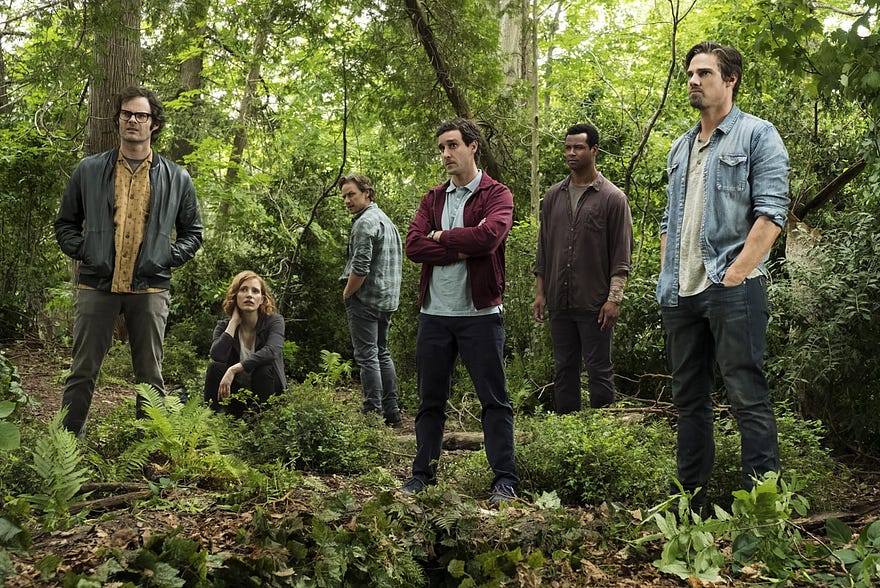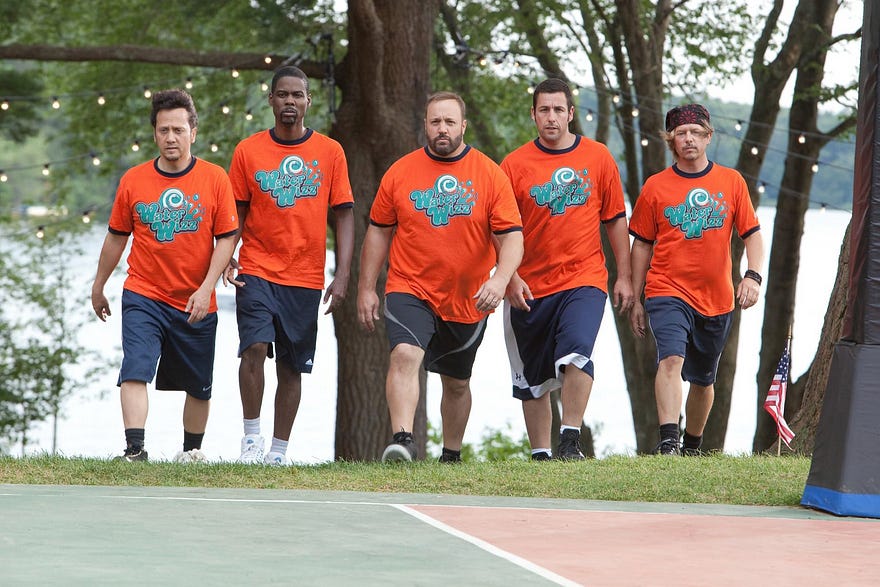‘It: Chapter Two’ — The ‘Grownups’ of Horror Movies
The masterpiece sequel that never fully materialized
By the sounds of it, It: Chapter 2 has all the makings of a hit movie. With an all-star cast, spearheaded by the unforgettable Bill Skarsgård as Pennywise the Clown, and a skilled team of writers, directors, and special effects artists, it was a follow-up poised to be one of the great horror films of the decade. But where it falls apart lies almost entirely in the feelings of warmth and nostalgia from the prior iteration that it woefully fails to recapture.
Where the first of the two It movies can be duly compared to Stand By Me in the childhood camaraderie It embodies, a fairer analogy for this follow-up would be to compare it to the 2010, Adam Sandler-starring, 10% Rotten Tomato-rated, Grown Ups.
Grown Ups, directed by Dennis Duggan, tells the potty-humored saga of a group of childhood friends reunited as grown-ups, 30 years later. In It: Chapter 2, we’re reintroduced to the protagonists from the first It, but 27 years later. And as with Adam Sandler and his boisterous co-ensemble of man-children, they’re not exactly endearing.
This renewed beginning entirely lacks the haunting ingenuity of the first film’s exposition. Though Jessica Chastain, Bill Hader, James McAvoy, James Ransone, Andy Bean, and Isaiah Mustafa are each seasoned actors in their own right, their simultaneous attempts to revivify the characters from nearly three supposed decades prior are both jarring and unconvincing. It’s as though each actor was told “I don’t know… just be an older version of this character. 3…2…1… action!” The result is unsurprisingly inauthentic.
Many actors describe their ability to immerse themselves in a role as a feedback loop. An authentic performance can elicit the same from co-performers and breathe life into otherwise mediocre movies. Heath Ledger’s unwound and mercurial portrayal of The Joker in The Dark Knight was so well realized that it demanded a certain level of excellence from fellow cast members. J.K. Simmons in Whiplash is one of the most apoplectic figures ever brought to the big screen, and his anger is so visceral that it can be palpably seen reflected on the face of his terrified classroom of barely-acting actors.
But the reverse is also true. A bad performance can be contagious. There’s scarcely an actor in It: Chapter 2 that could be called untalented, but the combination of them together in this scenario lacks conviction. It’s as though each actor decided from the onset not to give the film their fullest.
In the prior adaptation, it’s the naivety and immaturity of their younger counterparts that instill the story with a propulsive levity and humor. Even with Hader among the cast, though, this sequel vehemently struggles to recreate that same feeling of humor. The coming-of-age appeal of the characters’ budding adolescence is gone, too. In many regards, the movie feels more like a scattered love letter to itself than it does a sequel.
Of course, the quality of a performance often hinges on the screenplay. And in the case of It: Chapter 2, it’s one that’s disjointed at best and downright disorienting at worst. The characters seem like little more than the problems of their childhood left in echo chambers to fester. Their adult lives extend from their youth with a Freudian level of simplicity. Eddie Kaspbrak is still a fastidious, fast-talking hypochondriac. Stanley Ulris is still mired in his fears. Beverley Marsh is trapped in an identical cycle of abuse from almost thirty years prior. The exploration of other characters’ maturing is hardly more nuanced. Ben Hanscom, the only exception, somehow seems like the worst trope of all in his polar self-reinvention.
In addition to the lackluster portrayals of these characters, there’s a striking discordance for the viewer in the immediate recasting of every main character, sparing the titular It. As a series progresses, the occasional recasting is to be expected. Sometimes new characters cohesively fit into the narrative, and other times the transplant is rejected. But to replace an entire cast of beloved and charming children with their middle-aged counterparts is perhaps something that can only be achieved efficiently through words. The 1990 It, too, struggled to cast and reanimate the children of the first half of the mini-series.
To give credit where it’s due, each character, sparing Ben, does look like a convincing version of their childhood counterpart. To cement the comparison, the movie includes a gratuitous quantity of scenes featuring their younger selves. They feel as though they’re brought back to reintroduce some of the charm from the prior iteration, but end up arriving by and large as forced additions to a sprawling, overlong film.
It: Chapter 2 isn’t devoid of its strengths. Pennywise the Clown is as horrifying as ever. There’s a certain way in which the character benefits from remaining within the shadows and sewers of King’s timeless town. Still, some of the most chilling moments from the two movies take place in the second film.
Benjamin Wallfisch returns from the previous iteration to do the musical score, and like in the prior adaptation, does wonders to sell the suspense. But like the actors with limited scripts to work with, Wallfisch seems to have fewer poignant moments to channel his efforts into. As a result, his prowess is less well applied. Even still, Wallfisch works well within his constraints and crafts something that feels nearly on par with the prior It chapter.
One standout scare involves Beverley Marsh speaking with a frail, old lady inside her childhood home. The scene begins innocently enough. But the slow-growing sense of unease the viewer feels as it begins to grow clear that something is amiss is nothing short of masterful. The room’s energy grows gradually more and more foreboding. As Beverley begins examining an old photo, the viewer watches as the old woman begins moving naked through the background with a twisted and unnatural rhythm. The scene introduces some of the most macabre, memorable material in either movie.
Another moment that’s become famous among fans is Stephen King’s cameo as an antique shop owner. His ironic remark “But you’re the big author. You want it, you can afford it” to Bill Denbrough, who’s spent his career as a writer, is a great moment of comic relief. It stands for many as one of his best on-screen appearances.
As Pennywise stalks a child from underneath the bleachers after a baseball game, it musters something nearly as nightmarish as his introduction in the prior movie. Skarsgård is as sinister and formidable as ever before. In his scariest moments, he arises to something arguably more menacing than in even the prior It. But the scare struggles to persist through to the final act.
Jaws achieved its legend status, not by showing the titular creature, but by implying its carnivorous brutality. In It: Chapter 2, we see more of the infamous clown in his true form. But enough time spent on screen has a way of dulling some of his impact. Even after a gruelingly fragmented nearly three hours, the final battle and climax actually end up feeling unceremonious. The shape-shifting killer clown is taken out through what could accurately be called verbal abuse. However, in the case of Pennywise the Dancing, child-eating Clown, the beratings are probably given with good cause.
In the end, It: Chapter 2 leaves a strangely Sandler-esque taste in my mouth, and Bill Hader’s smirking face does little to dull it. Both movies bring together a powerhouse ensemble but fail to capitalize on their collective talents. Though in the case of Sandler’s comedy, that’s forgivable — probably even intentional.
But as the It: Chapter 2 credits roll, I can’t shake the feeling that, instead of cowering in fear of a terrible, face-painted menace, I’ve really just spent an afternoon fooling around with Sandler and his crew that’ve overstayed their time in their alma mater clown town. For some, maybe that’s what they’re looking for. But for those in search of child-maiming sewer demon scares, it’s a disorienting finale that feels almost more fit for a slapstick summer comedy than a horror epic. The horror of Derry is ultimately overshadowed by the real terror: the missed opportunity for a genre-defining sequel.




